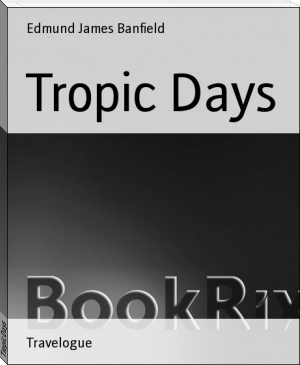Confessions of a Beachcomber by Edmund James Banfield (books to read to increase intelligence .TXT) 📖

- Author: Edmund James Banfield
Book online «Confessions of a Beachcomber by Edmund James Banfield (books to read to increase intelligence .TXT) 📖». Author Edmund James Banfield
COLOUR EFFECTS
A favourite food of the great green, gold and black butterfly (ORNITHOPTERA CASSANDRA) is the nectar of the hard, dull-red flowers of the umbrella-tree, and this fact assisted in an observation which seems to prove that plants play tricks on insects. Among the introduced plants of the island is one of the acalyphas. Butterflies which have feasted among the umbrella-trees on the beach and on the edge of the jungle flit about the garden and almost invariably visit the red but nectarless acalypha. One began at the end of the row, examined the topmost leaves, flitted to the next, and so on, lured by the colour and disappointed by the absence of nectar, twenty-five times, in succession, until it blundered on the red hibiscus bushes and began to feed.
The gorgeous blue swallow-tail (PAPILIO ULYSSES) seems to have a fancy for yellow, for it pays frequent visits to the golden trumpets of the tecoma and the alamanda. The living gold of the flowers and the imperial blue of the insect form a sumptuous if everyday scene.
MUSICAL FROGS
A marked feature of the wet season is the varied chant of happy frogs. During the day silence is the rule. A low gurgle of content at the sounding rain is occasionally heard on the part of a flabby, moist creature unable to restrain its sentiments until the approach of evening. But as the sun sets, each of the countless host utters a song of thankfulness and pleasure. To the unappreciative it may appear merely an inharmonious vocal go-as-you-please, in which each frog is the embodiment of the idea that upon its jubilant efforts the honour and reputation of the race as vocalists depend. But to one class of listener the opera is decently if not scientifically constituted. There is the loud and cheerful, if not shrill, bleating of the soprano, the strenuous booming of the bass, the velvety softness and depth of the contralto and the thin high tenor. Hordes of the alert, sharp-featured, far-leaping grass frog represent the chorus, and they have a perfectly rehearsed theme. Down on the flat along the edge of the pandanus grove the preliminary chords are uttered--a merry, unreflective, chirrupy strain, gay as "the Fishermen's Chorus." The motive is taken up nearer among the coco-nuts, and is in full swing in the pools below the terrace. Thence the sound passes on through the wattles and bloodwoods to the narrow tea-tree swamp lined with dwarf bamboos and dies in echoes in the distance. A brief interlude, and the pandanus choir gives voice again, stronger and resonant; the companions of the coco-nuts join lustily, the strain reverberates from the wet lands below, resounds through the forest, and is lost in the mellow distance of the tea-trees. And so the sound rises and falls, swells and dwindles away in chords and harmonies, until presently every amphibian is alert and tremulous with emotion and emulation. If an attempt is made to analyse the music, you may discover sounds sharp as those of the fife, deep and hollow as drum-beats, sonorous and acrid, tinny and mellow.
I have heard that those who are not disciples of Wagner find it necessary to undergo a process of education ere they acquire an unaffected taste for the composer's masterpieces. Possibly those who have not listened, wet season after wet season, to the light-hearted chant, may be inclined to suggest that there can be no such thing as music in the panting bellows of a North Queensland frog. But music "is of a relative nature, and what is harmony to one ear may be dissonance to another." The Chinese opera proves that "nations do not always express the same passions by the same sounds." If one obtains music from the clang and clamour of full-throated frogs, may it not be because his ears are more attuned to natural than to artificial harmonies, not because, of any defect in, or aberration of, hearing, or any lack of melody on the part of the frogs?
ACTS WELL ITS PART
"A living drollery! Now I will believe That there are unicorns; that in Arabia There is one tree, the phoenix throne; one phoenix At this hour reigning."
Few insects repay observation better than the mantis and the stick insect, which generally, of most voracious habits themselves, resort to all manner of disguises and devices to elude their enemies and lure their prey. Nearly all furnish striking examples of colour protection. One variety of the mantis here is black and rugged, and is to be found only on charred wood. The wing-cases present the characteristic grain and glint of fresh charcoal, distinctly showing the influence of the condition of its environment. Another is grey, to match its groundwork of dead wood; another brown and slightly hairy, to coincide with the bark of the particular eucalyptus upon which it lurks. Another, and the most graceful, resembles two bright green leaves, the midrib and the nerve system being imitated perfectly.
Among the most singular is one of the stick insects (PHASMA). A fair specimen may be a foot and more long. The body presents the general appearance of a dry stick; the posterior legs, held at different and erratic angles to the grey and brown body, are as sunburnt twigs; the intermediary pair seem to be used primarily as supports. The anterior are stretched out to their fullest extent parallel to each other, and so close together as to resemble one tapering termination, with the head closely packed between the thighs, in each of which is a complementary depression for its accommodation. When the insect is motionless it is difficult to detect. By its long posterior legs, stiffly held aloft, it proclaims to every bird--"Do not be so absurd as to imagine these dry twigs to be legs, belonging to a body good to eat." And if the bird does not take the resemblance for granted and is inquisitive and approaches too familiarly, it finds that instead of a dinner it has discovered a snake. The insect seems to say--"I am a stick! Look at the twigs. No, I am a snake! Long live the serpent!"
The long, slender anterior legs--used more frequently as arms than as legs--form the tapering tail; the other end is the head with mouth open, ready for action--eyes and jaws and protruding tongue complete. This end sways as does the head of an excited snake, and curves round as if to strike, and the boldest of little birds fly off with a note of apprehension and alarm. I have had these strange creatures under observation many weeks, and invariably found that when one was interfered with in any way it used its snake-like aft end as a bogey, curving it round towards the molesting hand. A fowl that will attack an 8-inch centipede without hesitation, makes a sensational fuss and clatter when it detects a stick insect, especially when the stick insect feints, however ineffectually, with its perfectly harmless tail. If it is capable of imposing upon a sagacious fowl, the effect of its terrifying aspect upon an unsophisticated little bird can well be understood.
Richard Kerr, the author of NATURE: CURIOUS AND BEAUTIFUL, describes a specimen of the stick insect from a cabinet specimen and a pen-and-ink drawing in the museum of the Hon. W. Rothschild, at Tring. This particular insect originally came from Malacca, and is jointed somewhat after the style of a Malacca cane, and of it the author says--"It is said that when the insect is attacked by its foe, or is in danger of attack, it has the power to protrude telescopically the tenth (terminal) segment, which has a mouth-like opening and a tongue-like organ which at once gives the creature the appearance of a snake. There is also a spot that answers to the appearance of an eye on the ninth segment."
The Dunk Island representative of the family does not possess the power of protruding and withdrawing its terminal segment, but it certainly assumes a resemblance to a snake, and a pugnacious snake too. Further, the Tring insect does not appear to possess wings. My friend does--though she flies as the Scotchman admitted he joked--"wi' deefeeculty." She spreads her light, gauzy, grey, and shockingly inadequate, skirts, and romps and rollicks away, giving one a fleeting impression of a bold and most disorderly ballet girl. "She" is quite the proper mode of address, for there can be no mistake as to the sex.
The male is a slim individual, not half the length, and about one-fourth of the circumference of the female. Though (unlike his consort) he is in his general demeanour sprightly and alert, taking to the wing at the slightest impulse, in his love-making he is most deliberate, courtly and formal, the consummation of it all continuing for several days. So we see that the character of the snake which the female plays with so much art is not disturbed during the most emotional period of her existence. Nature holds the mirror to herself with inimitable skill. While the male takes long flights, those of the female are short and uncertain and seldom voluntary. Immediately she alights the anterior legs are extended, the head is depressed between the thighs, and the legs which are at liberty become as rigid as twigs. Among the branches of a shrub her action is cautious and stealthy; but the stick insect is seldom to be caught napping. It is very wide awake when it plays the dual part of a sleepy snake and four crooked twigs. In youth, the colouring of the female is ashy green, almost exactly the tint of the most common of arboreal snakes, and at the time of life when it is less able to defend itself it seems to spend all its days in the snake-like posture.
In some respects this insect resembles the MANTIS RELIGIOSA; but it does not seem to possess the voracious appetite of that insect, which assumes the supplicatory attitude that it may the more readily seize its prey. Indeed, although two specimens were under observation for three months, at morning, noon and eve, I only once saw one eating, and then it was partaking sparingly of orange leaves. The insect is well-known as a vegetarian, but the manner of its feeding is singular. The part that it takes of a motionless snake would be ineffective if the head moved while eating, and Nature provides against any blundering of that sort. The edge of a leaf is guided to the mouth, which appears to open vertically--not horizontally as mouths usually do--by a set of palpi or feelers, three on each side. The palpi move the leaf along, the while a crescent-shaped strip is rapidly nibbled away. Then they move the leaf back again to the original starting point, and another crescent is devoured, and so on, while the extended anterior legs, hooked on to a twig, pull the body forward with a gliding, almost imperceptible motion as the leaf is gradually consumed. Between meals, the palpi are folded flat close to the mouth, like the blades of a pocket-knife.
Blacks classify most of the works of Nature under two headings--"Good to eat," "Not good to eat," and nearly everything is included under the former. The "Taloo" or "Yam-boo" is included in the larger class. Ruthlessly deprived of its limbs, the insect is placed squirming on hot embers until it becomes crisp, when it is eaten with great relish.
GREEN-ANT CORDIAL
White ants, black ants, red ants, brown





Comments (0)